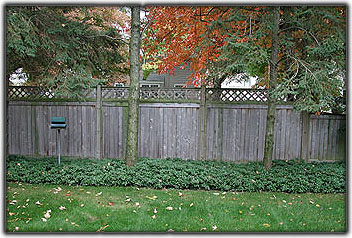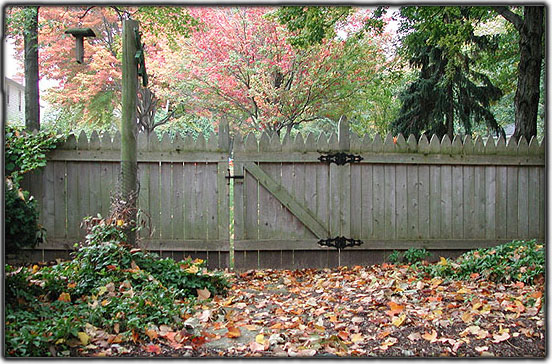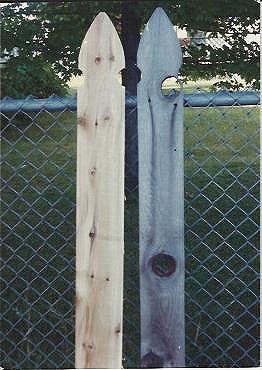


White Cedar is the board on the left ~ Red Cedar is the board on the right (make note of the large holes - the red cedar board tends to lose its knots creating a hole. An issue that doesn't affect Northern White Cedar boards).
Long Life and Durability of the fences, pergolas, arbors, and trellises by Elyria Fence
There are numerous reasons why Elyria Fence demands Northern White Cedar for its fences. The most important are its long life and durability. Through time, White Cedar will weather out to a gray. This should be the only change that takes place in the fence. Out of all the species of wood White Cedar exhibits the least amount of shrinkage. This means your solid privacy fence will remain a privacy fence. Due to the small size of the White Cedar tree its knot holes are small. This results in the board retaining the knots versus losing them as in a Red Cedar board. Often times a fence constructed of Red Cedar will lose its knots within a few years. Obviously, this leaves the customer with a fence which has large holes in it. Of course, the most important trait to a White Cedar fence is its long life. If left untreated, such as the fences above, you should expect it to last approximately twenty years.
There are a few properties that are unique to wood especially treated wood. All wood will have cracks or checks, but it is primarily noticed in treated posts. This is a natural phenomenon that is part of the drying process. As tension develops in the wood due to shrinkage, the post splits to relieve tension. These splits or cracks are known as “checks” in the post. The check will not affect the structural integrity of the post. The checks are natural and are part of the character of wood products. Keep in mind that a post that has checked will have less of a tendency to warp and twist. An example of checking is shown in the bottom left photo, however, please note that the post shown is not a product that we carry. In addition, galvanized and aluminized fasteners have a tendency to react with Northern White Cedar. This will create a bleeding look on the boards near the nail. This does not happen on every board or on every installation, but it could happen! Both checking and bleeding are avoidable if the customer stains the fence immediately after the installation. Of course staining your fence with a good quality stain will double the life of your fence.
If you choose to not the stain the fence, but to let it weather as in the photos above it would be wise to not pile mulch, flower boxes or anything else that might trap moisture against the fence. This will only shorten the life of your investment! If your intentions are to place a flower bed near your weathered fence we highly recommend that you stain the area behind the mulch with a good "clear" stain to act as a water repellent. For more information on stain, please click here to take a look at our recent blog entry on stain. Lastly, all of the White Cedar that we use is a rough sawn White Cedar - it is not available as a smooth board. Over time most of the roughness of the board dissipates.
Elyria Fence Inc ~ 230 Oberlin Rd, Elyria, OH 44035 ~ 440-323-7581 ~ info@elyriafence.com
